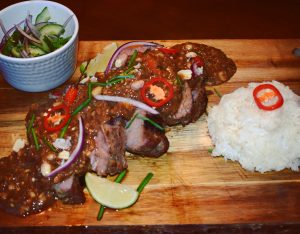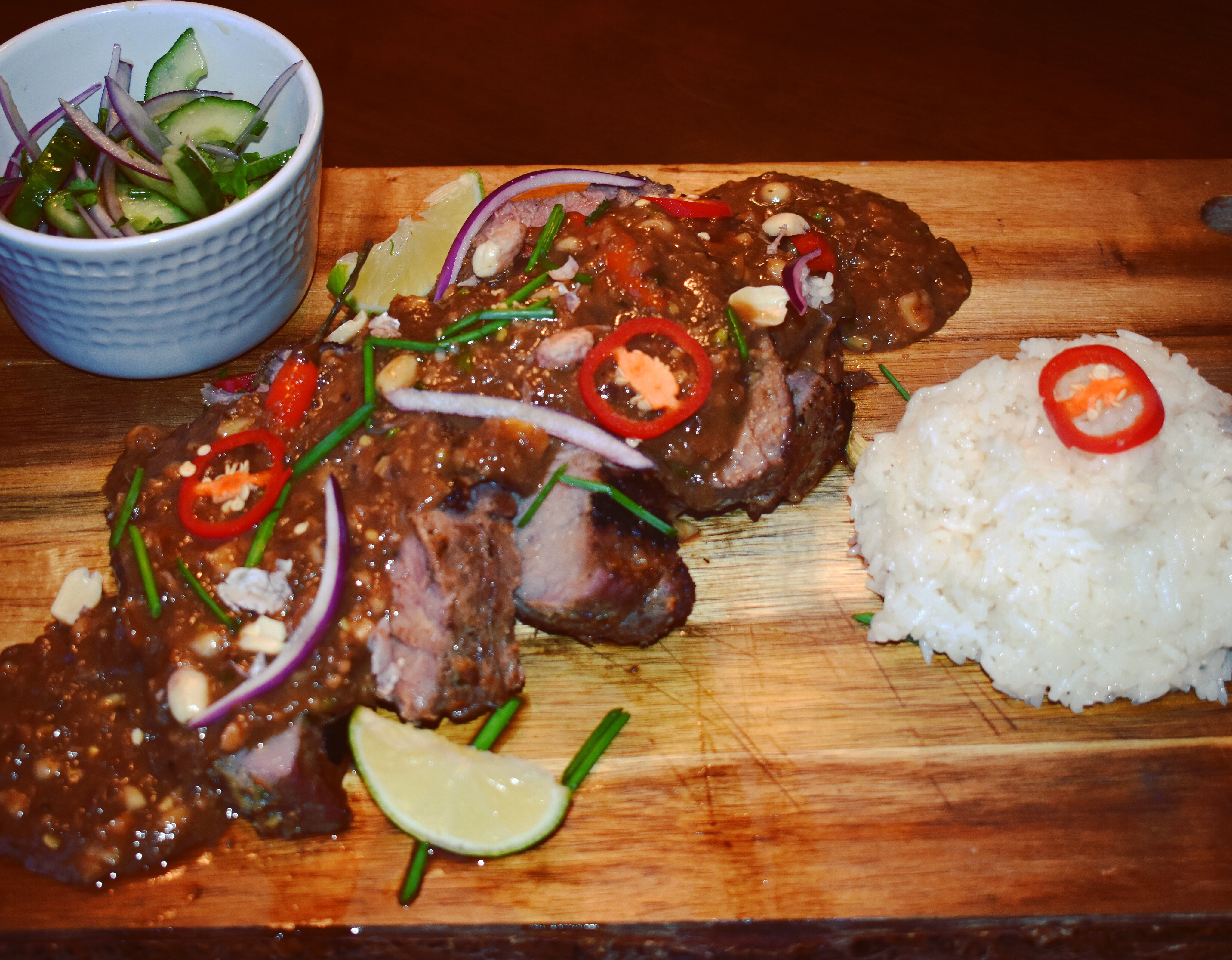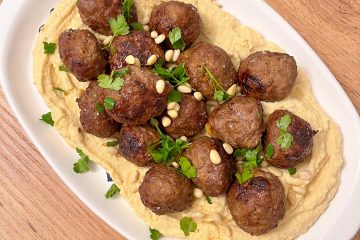Thai Massaman Steak Sharing Board. I was challenged by my butcher Chris from Bannerman Butchers to create a dish with a less well known cut of beef- the Tri Tip Steak. If you haven’t heard of it, the tri tip comes from underneath the sirloin, and is also known as bottom sirloin (as opposed to top sirloin) or Californian cut. I have no idea why it isn’t more popular. The marbling fat gives amazing flavour and unlike other less well known, cheaper cuts that need slow cooked due to their tough nature, the tri tip is tender enough to be cooked like a steak. One of the best things about it is that it is also a great size to share between two as I have done in this recipe.
In June I am travelling to Asia to travel around for two months and I can’t wait to taste the flavours of Asia properly! I was therefore inspired to try out some Thai flavours in advance. This Thai Massaman Steak is quite mild in heat, but is packed full of flavour and spices. It is always better to make pastes yourself. You can even double the paste ingredients and freeze half for another time. Let me know in the comments below if you have tried tri tip steak before and how you had it!
มัสมั่นแกงแก้วตา หอมยี่หร่ารสร้อนแรง –
“Massaman, a curry made by my beloved, is fragrant of cumin and strong spices”
RECIPE
SERVES 2
DIFFICULTY LEVEL Home Cook
Ingredients:
For the Thai Massaman Steak:
- Tri tip steak (ask your butcher for this cut- I got from Bannerman Butchers)
- 150g Thai sticky rice,soaked overnight in water or for at least four hours
- 1 cinnamon stick
- 1 tin of coconut milk
- 4 lime leaves (I buy them frozen from the Asian supermarket)
- 30g unsalted peanuts, finely chopped
- 1 red onion
- 4 birds eye chillies, cut in half lengthways
- 1 tablespoon tomato purée
- 1 tablespoon soy sauce
- 300ml stock (use beef, chicken or vegetable- homemade chicken stock would be best)
- 1 lime
- 2 tablespoons fish sauce
- 1 tablespoon tamarind paste
- A bunch of Thai chives, Chinese chives or Thai basil
- Olive oil
For the paste:
- 1 red onion, roughly chopped
- 5 garlic cloves, bashed with a large knife and peeled
- Thumb piece size of galangal, roughly chopped
- 2 sticks of lemon grass, outer leaves discarded, inner core bashed and roughly chopped
- 5 cardamon pods, shells removed and discarded
- 1 star anise
- 2 teaspoons cumin seeds
- 4 cloves
- Two teaspoons white pepper
- 1 tablespoon dried chilli flakes
- 1 teaspoon each of ground coriander and ground cinnamon
- About ten gratings of a nutmeg
- 2 tablespoons peanut butter (use one with no added sugar)
- 1 tablespoon shrimp paste
- 3 tablespoons fish sauce
- 2 tablespoons of grated palm sugar
- 1 teaspoon salt
- Olive oil
- Water
METHOD:
- First make the paste. Toast the cumin seeds, star anise, cardamon seeds and cloves in a dry frying pan over a medium heat for around a minute. Bash in a pestle and mortar until ground.
- Place all the ingredients for the paste including the toasted ground spices, a tablespoon of oil and two tablespoons of water into a food processor or your pestle and mortar. Whizz or bash to a paste.
- Cover the steak with half of the paste and marinate for as long as you can, ideally around four hours.
- Preheat the oven to 220C.
- Finely dice the red onion and place in a large frying pan over a medium heat with a splash of olive oil. Cook for 10 minutes, stirring frequently until softened.
- Add the remaining paste to the pan and cook for a couple of minutes, stirring.
- Add the half the tin of coconut milk, the tomato purée, the lime leaves, the palm sugar, the cinnamon stick, the chicken stock, the fish sauce,the soy sauce, the tamarind paste and the chillies. Simmer over a low heat for around 20 minutes, adding water if it is getting too thick.
- Place a large, ovenproof frying pan on a high heat. When hot, sear the beef all over for about 2 minutes. Place in the oven for 18 minutes for a medium steak. Remove from the oven and allow to rest for at least 5 minutes.
- Whilst the steak is in the oven, cook the sticky rice. Line a bamboo steamer with grease proof paper, place the drained rice on top and cover the steamer with the lid. Place the steamer on top of a pan of boiling water, ensuring the steamer does not touch the water. Make sure the water does not evaporate. Steam for around 15-20 minutes. When the rice is done it will be soft and sticking together. Drain the water from the pan and put the rice in it along with a small grind of salt and the remaining coconut milk. Stir until absorbed.
- Add the lime juice and chopped peanuts to the sauce and stir through before tasting for seasoning. Add more fish sauce, soy sauce or water if needed.
- Slice the steak thickly and serve on a board with the sauce drizzled over. Garnish with extra sliced red onion, birds eye chillies, Thai chives and peanuts. Serve with the sticky rice on the side.

Tips
- Goes well with a Thai cucumber salad- simply mix half a de-seeded and chopped cucumber with half a thinly sliced red onion, 2 finely chopped birds eye chillies, a handful of chopped fresh mint and a crushed clove of garlic. Dress with two tablespoons fish sauce, the juice from one lime, a teaspoon of palm sugar and two tablespoons of rice vinegar.
- Substitute chicken for the beef. Simply fry chunks of chicken thighs in the paste before adding the rest of the ingredients. (You will only need half of the paste unless you want to marinate the chicken first)
- Cashews could be used instead of peanuts
- Authentic Thai ingredients such as lime leaves, palm sugar and galangal will make all the difference
If you enjoyed my Thai Massaman Steak sharing board, you may also like my Red Thai Prawn Curry












Pingback: Christmas Dinner Pie - Documenting My Dinner
Pingback: Thai Chicken with Cashew Nuts - Documenting My Dinner